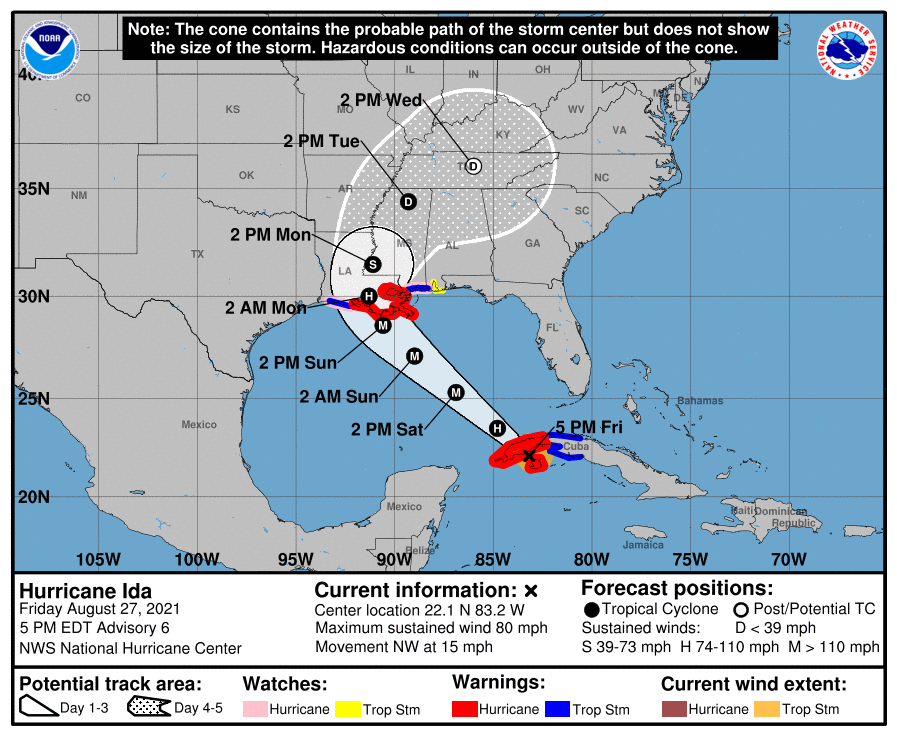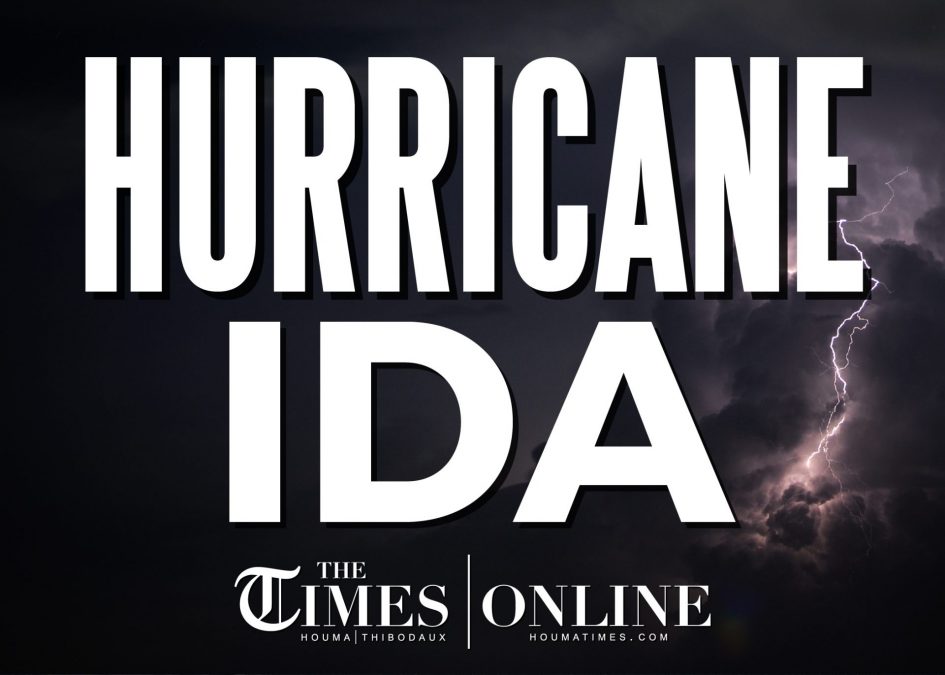
Ida expected to be major category 4 hurricane at landfall
August 27, 2021
Terrebonne General Health System Prepares for Hurricane Ida
August 27, 2021As the storm nears our area, the window to evacuate safely is closing. Impacts from what is forecast to be a major hurricane could begin as early as Saturday in areas along the coast. Areas well inside the state could see hurricane force winds and torrential flooding beginning Sunday. Now is the time to finalize your plans. There will likely be major power outage issues. Travel could be restricted due to flooding and other problems. If you plan to evacuate, check 511la.org for road closure information and make sure you bring along adequate supplies. Include masks and other PPE due to the latest COVID-19 surge. Call 211 for shelter updates. Don’t forget your pets. Plan for any needs associated with your pets. Stay informed and check/re-stock your emergency supplies. Emergency planning starts with individuals and families.
Prepare a personal evacuation plan.
- Identify ahead of time where you could go if you are told to evacuate. Choose several places- a friend’s home in another town, a motel or a shelter.
- Keep handy the telephone numbers of these places as well as a road map of your locality. You may need to take alternative or unfamiliar routes if major roads are closed or clogged.
- Listen to NOAA (www.noaa.gov) Weather Radio or local radio or TV stations for evacuation instructions. If advised to evacuate, do so immediately.
Know what to do when a hurricane WARNING is issued.
- Listen to the advice of local officials, and leave if they tell you to do so.
- Complete preparation activities.
- If you are not advised to evacuate, stay indoors, away from windows.
- Be aware that the calm “eye” is deceptive; the storm is not over. The worst part of the storm will happen once the eye passes over and the winds blow from the opposite direction. Trees, shrubs, buildings, and other objects damaged by the first winds can be broken or destroyed by the second winds.
- Be alert for tornadoes. Tornadoes can happen during a hurricane and after it passes over. Remain indoors, in the center of your home, in a closet or bathroom without windows.
- Stay away from flood waters. If you come upon a flooded road, turn around and go another way. If you are caught on a flooded road and waters are rising rapidly around you, get out of the car and climb to higher ground.
If local officials haven’t advised an immediate evacuation:
- If there’s a chance the weather may get worse or flooding may happen, take steps now to protect your home and belongings. Do this only if local officials have not asked you to leave.
Protect your home.
- Bring things indoors. Lawn furniture, trash cans, children’s toys, garden equipment, clotheslines, hanging plants, and any other objects that may fly around and damage property should be brought indoors.
- Leave trees and shrubs alone. If you did not cut away dead or diseased branches or limb from trees and shrubs, leave them alone. Local rubbish collection services will not have time before the storm to pick anything up.
- Look for potential hazards. Look for unripe fruit, and other objects in trees around your property that could blow or break off and fly around in high winds. Cut them off and store them indoors until the storm is over.
- Turn off electricity and water. Turn off electricity at the main fuse or breaker, and turn off water at the main valve.
- Leave natural gas on. Unless local officials advise otherwise, leave natural gas on because you will need it for heating and cooking when you return home. If you turn gas off, a licensed professional is required to turn it back on, and it may take weeks for a professional to respond.
- Turn off propane gas service. Propane tanks often become dislodged in disasters.
- If flooding is expected, consider using sand bags to keep water away from your home. It takes two people about one hour to fill and place 100 sandbags, giving you a wall one foot high and 20 feet long. Make sure you have enough sand, burlap or plastic bags, shovels, strong helpers, and time to place them properly.
- Remember Houses do not explode due to air pressure differences. Damage happens when wind gets inside a home through a broken window, door, or damaged roof.
- Cover the outside of windows with shutters or plywood. Use shutters that are rated to provide significant protection from windblown debris, or fit plywood coverings over all windows. Tape does not prevent windows from breaking. All tape does is prevent windows from shattering. Using tape on windows is not recommended.
Protect your valuables.
- Move objects that may get damaged by wind or water to safer areas of your home. Move television sets, computers, stereo and electronic equipment, and easily moveable appliances like a microwave oven to higher levels of your home and away from windows. Wrap them in sheets, blankets or burlap.
- Make a visual or written record of all of your household possessions. Record model and serial numbers. This list could help you prove the value of what you owned if those possessions are damaged or destroyed, and can assist you to claim deductions on taxes. Do this for all items in your home, including expensive items such as sofas, chairs, tables, beds, chests, wall units, and any other furniture too heavy to move. Store a copy of the record somewhere away from home, such as in a safe deposit box.
Prepare for high winds.
- Install hurricane shutters or purchase precut 1/2″ outdoor plywood boards for each window of your home. Install anchors for the plywood and predrill holes in the plywood so that you can put it up quickly.
- Make trees more wind resistant by removing diseased and damaged limbs, then strategically removing branches so that wind can blow through.
Caring for Pets During An Emergency
FEMA – Animals and Emergencies
Locate PET-FRIENDLY Hotels & Motels
Don’t forget your pet when preparing a family disaster plan.
Contact your veterinarian or local humane society for information on preparing your pets for an emergency.
BEFORE THE DISASTER
- Make sure that your pets are current on their vaccinations. Pet shelters may require proof of vaccines.
- Have a current photograph.
- Keep a collar with identification on your pet and have a leash on hand to control your pet.
- Have a properly-sized pet carrier for each animal – carriers should be large enough for the animal to stand and turn around.
- Plan your evacuation strategy and don’t forget your pet! Specialized pet shelters, animal control shelters, veterinary clinics and friends and relatives out of harm’s way are ALL potential refuges for your pet during a disaster. If you plan to shelter your pet – work it into your evacuation route planning.
DURING THE DISASTER
- Animals brought to a pet shelter are required to have: Proper identification collar and rabies tag, proper identification on all belongings, a carrier or cage, a leash, an ample supply of food, water and food bowls, any necessary medications, specific care instructions and news papers or trash bags for clean-up.
- Bring pets indoor well in advance of a storm – reassure them and remain calm.
- Pet shelters will be filled on a first come, first served basis. Call ahead and determine availability.
AFTER THE DISASTER
- Walk pets on a leash until they become re-oriented to their home – often familiar scents and landmarks may be altered and pets could easily be confused and become lost. Also, downed power lines, reptiles brought in with high water and debris can all pose a threat for animals after a disaster.
- If pets cannot be found after a disaster, contact the local animal control office to find out where lost animals can be recovered. Bring along a picture of your pet if possible.
- After a disaster, animals can become aggressive or defensive – monitor their behavior.
PET DISASTER SUPPLY KIT
- Proper identification including immunization records
- Ample supply of food and water
- A carrier or cage
- Medications
- Muzzle, collar and leash
Plan for your pets
Animal ownership is a personal responsibility and properly caring for your animals during a storm and possible evacuation takes careful preparation and planning ahead of time.
Make sure your pets have proper identification – preferably something permanent like a microchip or tattoo and collars with identifying tags.
Important items concerning pets to take along during an evacuation: health records, 3-day food and water supply, pet carriers, leashes, harnesses, muzzles, special medications.
Exotic pets, like snakes and lizards, should be contained at all times and owners need to bring extension cords for plugging in heat rocks and lamps.
Take digital or film pictures of any identifying marks on the pet in order to prove ownership.
Plan for cattle and horses
Cattle and horse owners should move their livestock on their property that is least likely to flood where a herd can quickly and easily be moved when a hurricane threatens the area.
Owners of expensive or genetically superior breeding stock should consider transporting their animals with them during an evacuation.
It’s important for livestock owners who plan to evacuate with a trailer of animals to leave as early as possible. During hurricane evacuations it is not unusual for routes to close to trailer and towing traffic.
Bring health records, food, special medications, bridles, leads, rope, etc. For horses, be sure to bring proof of EIA testing.








